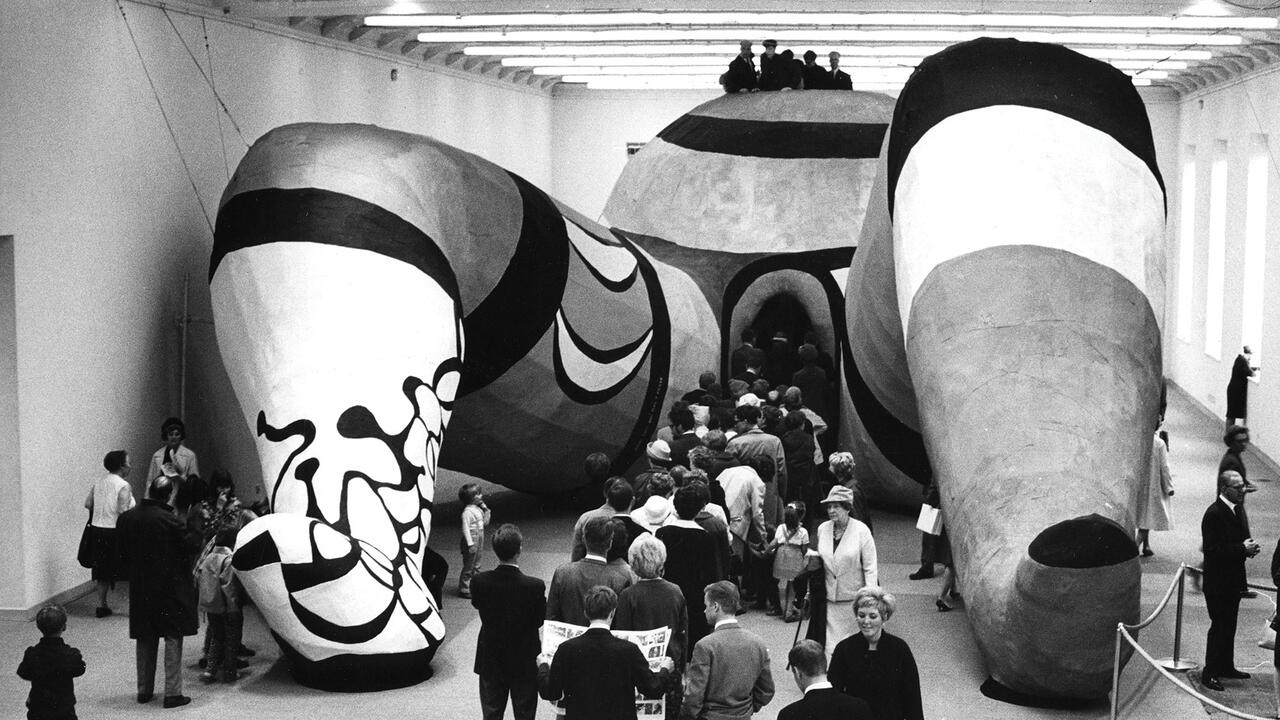Niki de Saint Phalle
Guggenheim Bilbao, Spain
Guggenheim Bilbao, Spain

Margaret Atwood once recounted asking a male friend why men feel threatened by the opposite sex. ‘They’re afraid women will laugh at them,’ he responded, ‘[and] undercut their world view.’ When she asked a group of female students why the reverse was true, they answered: ‘They’re afraid of being killed.’ Over the course of the French-American artist Niki de Saint Phalle’s restlessly inventive four-and-a-half decade career, she used both violence and laughter to rail against gender inequality and patriarchal oppression in ways that were at times as simplistic as they were brave and bitingly direct. Curated by Camille Morineau and Álvaro Rodríguez Fominaya, and organized in collaboration with the Grand Palais, Paris, where it opened last year, the retrospective at Guggenheim Bilbao included over 200 works, presented in chronological order.
In February 1961, behind the artists’ studios lining the impasse Ronsin (a side street in Paris’s 15th arrondissement), Saint Phalle used a .22 rifle borrowed from a nearby fairground stall to shoot a series of reliefs – plaster-covered assemblages of toys, tools and household bric-a-brac – in which she had embedded sacks of paint. When hit, they exploded, spraying the entombed objects with bursts of colour. This was the first of Saint Phalle’s ‘Tirs’ (Shooting Paintings) – a technique and a performance that she would repeat on numerous occasions over the next two years. A group of friends – including her future husband, Jean Tinguely, Daniel Spoerri and the critic Pierre Restany – was present, as were the photographers Harry Shunk and János Kender, who immortalized her as the girl with a gun: a fresh-faced, beautiful former model, pointing a rifle.
The paintings themselves are grotesque, their raised surfaces wounded and clotted, their entrails spilled as though the assemblages themselves were bodies. Often, what they depict is furiously symbolic – altarpieces, politicians and monsters, all are ritually disembowelled by Saint Phalle’s marksmanship.
In a sense, the ‘Tirs’ respond to André Breton’s famous claim that ‘the simplest surrealist act consists in going into the street, revolver in hand, and shooting at random into the crowd’. Breton’s was a call for anarchy, the refusal of power structures of any kind, which acknowledged – gleefully – the dangers and violence of unchecked desire. Saint Phalle recognized both the constructive and destructive power of this kind of liberation. (It’s hard not to read the ‘Tirs’ – particularly that which occurs in the final sequence of her 1973 film, Daddy – as a form of revenge for the sexual abuse that she suffered as a teenager at the hands of her aristocratic father: his symbolic destruction paves the way for her self-invention as an artist.) But Saint Phalle doesn’t take herself as seriously as Breton. The ‘Tirs’ are powerful precisely as a form of play-acting, theatricalizing aggression to show it to be hyper-masculine peacockry. The exploded drips exaggerate to the point of parody Jackson Pollock’s paintings and the idea of masculine physicality as the archetypal artistic gesture. In Kennedy–Khrushchev (1962), which depicts the warhead-wielding US president and Soviet premier with grinning masks, locked in an adulterous Siamese embrace, Saint Phalle performs a double emasculation. She wields the weapon whilst, below a garter belt made of baby dolls, the conjoined figure has a vagina with the matted, spiky appearance of a split sweet-chestnut case.
The route to a second series of rooms was lined by inflatable ‘Nanas’ – the voluptuous, primary-bright mother goddess figures that first appeared in Saint Phalle’s work in 1964, inspired by the pregnant form of her friend, Clarice Rivers. Produced in various guises until the years immediately preceding the artist’s death in 2003, they have become her aesthetic signature. (She even lived in one for a while – the immense Empress sculpture in her Tarot Garden in Garavicchio, Italy, which opened to the public in 1998 after 20 years of construction.) A wall text at the Guggenheim described the ‘Nanas’ as ‘warriors in the feminist battle’, their bodies expressing ‘femininity without restraint, feminism with a smile’. I am unconvinced. Their appeal to an essentializing, voluptuous maternity is simplistic and anachronistic – even for the late 1960s and early ’70s, when second-wave feminists were fighting to divorce feminine identity from biological function. More interesting is Saint Phalle’s series of ‘Devouring Mothers’, sculptures and sketches made in the early 1970s. Darker versions of the earth mother archetype, these dowdy matriarchs take tea with babies in place of cakes; one swallows Daddy whole.
What these sculptures made clear is that the Nana is emphatically not a representation of Saint Phalle. In one television clip from the late 1960s playing alongside the sculptures, the waif-like artist poses in front of a giant, broad-shouldered ‘Nana’, whose scale dwarfs her. There is something tragic in the fact that Saint Phalle could only create a positive, unashamedly celebratory figure of femininity that was so far removed from her own image. But there is something irritating and slightly condescending about this discrepancy, too: it’s like being told that ‘big is beautiful’ by a friend who is stick thin.
Ultimately, this was a show about the myth of Saint Phalle: her journey; her triumphs over monsters, physical and psychological; her heroism. All of this deserves recognition, but the artist’s hyper-visibility – in the masses of photographs and reels of archival footage – only highlighted how clunky, physically and conceptually, the ‘Nanas’ are by comparison. Ultimately, there was only one goddess here: the artist herself.
























